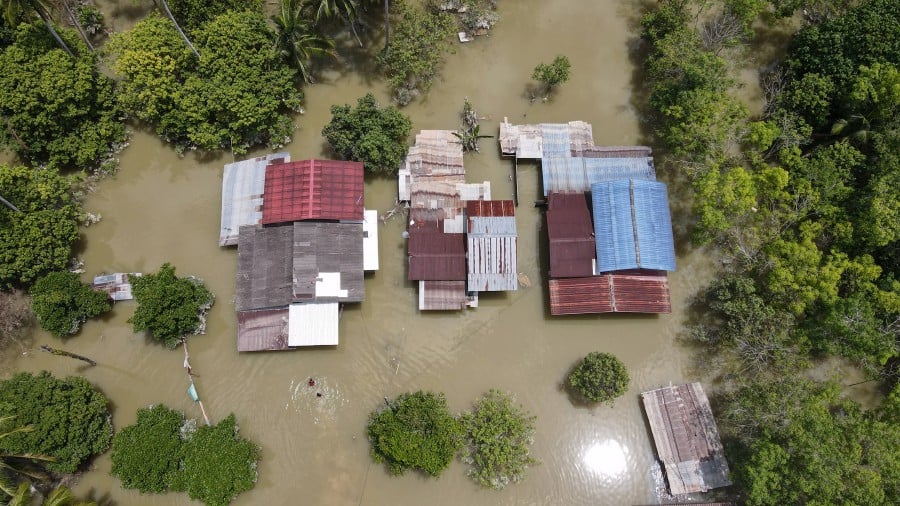Floods can cause direct and indirect losses to people's lives and livelihoods.
The 2014 floods, then dubbed the largest flooding event in a century, saw Kelantan the worst hit compared with other states such as Terengganu, Pahang and Johor.
A total of 541,896 people were displaced, 25 died and 2,076 houses were destroyed with another 6,696 damaged.
According to the National Disaster Management Agency's 2018 annual report, the damage caused by the 2014 floods was estimated at RM2.9 billion.
The floods at the end of last year could be worst. The Department of Statistics stated that the losses incurred by the affected states were RM6.1 billion.
Public assets and infrastructure recorded the highest losses at RM2 billion followed by RM1.6 billion for housing and RM1 billion for vehicles. The manufacturing, business and agriculture sectors combined accounted for RM1.49 billion in losses.
Selangor, the worst-hit state, incurred residential and vehicle losses totalling RM1 billion and RM855 million, respectively. Pahang came in next with RM425.6 million and RM78.2 million in residential and vehicle losses, respectively.
As for the flood victims, returning to normal life was not easy. Post-flood recovery required financial and non-financial inputs.
In terms of financial aid, the government had unveiled the Malaysian Family flood relief package worth RM1.4 billion, interest-free loans to help ease the burden of affected households, micro, small and medium enterprises, informal entrepreneurs and padi farmers.
However, it would still not be able to cover the full losses and costs suffered.
Those with takaful or insurance flood cover would get some relief from the compensation payable in respect to the loss or damage caused by the floods.
Unfortunately, a Zurich Malaysia survey in September last year involving 1,201 respondents showed that only 26 per cent of Malaysian houseowners were covered for floods.
In other words, despite regular flash floods and cyclical monsoon seasons, 74 per cent of homes in Malaysia are not covered for floods.
The survey also revealed that 59 per cent of homeowners were not insured against fire incidents.
The Malaysia Property Market Centre data showed that there are about 5.8 million residential properties in Malaysia. This means that more than half of the total homes in the country are not covered by takaful or insurance against potential damage.
Meanwhile, Insurance Services Malaysia statistics showed that only four per cent of motorists chose comprehensive policies that included flood cover last year.
The data concurred with a report by an online news portal that most workshops in Shah Alam said that less than two per cent of flood-damaged cars sent for repairs were insured against special perils, including floods.
The cost of repair varies depending on the damage and the vehicle model.
For example, the cost to repair an Axia or a Myvi could range from RM18,000 to RM22,000.
In many European countries, insurance is a basic socio-economic requirement.
In Malaysia, the importance of having takaful and insurance, as well as flood cover, is still low among the citizens. This is evident from the findings of Zurich Malaysia and ISM.
In most cases, people only realise the importance of insurance coverage after they experience a traumatic event.
As time flies, they tend to forget about it and discontinue the cover when the time comes to renew it.
This mindset should change as takaful or insurance is not about predicting what will happen. It is an early effort taken to cover unforeseeable losses.
In Malaysia, there is no separate takaful or insurance policy that offers flood cover to consumers.
Currently, flood cover is optional and offered as an extension under motor (comprehensive) and fire (basic) policies subject to additional contribution or premium.
Besides motor and fire policies, the cover could also be included in a houseowner's and householder's policy.
As nine per cent of Malaysia's land is flood-prone, and 4.8 million people live in areas at risk of flooding, combined with climate change, equatorial climate and monsoon seasons, flood cover should be a matter of great concern to us.
As such, it is wise to adequately insure properties and belongings to minimise the financial impact of such a peril, should it arise.
The writer is a fellow at the Centre for Economics and Social Studies, Institute of Islamic Understanding Malaysia
The views expressed in this article are the author's own and do not necessarily reflect those of the New Straits Times






